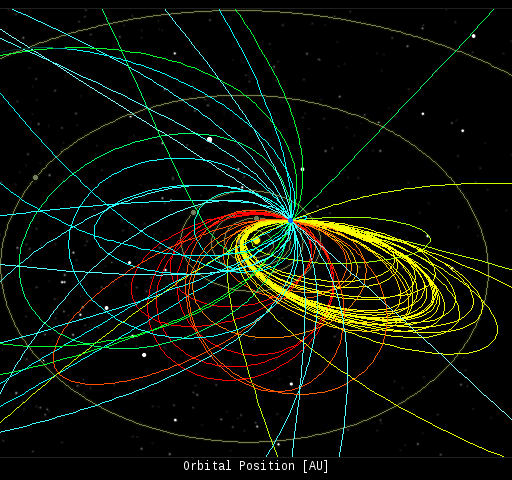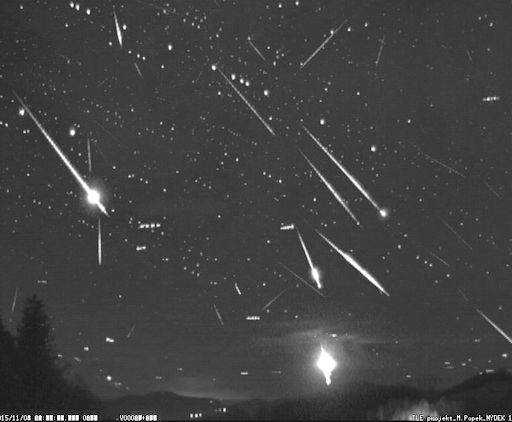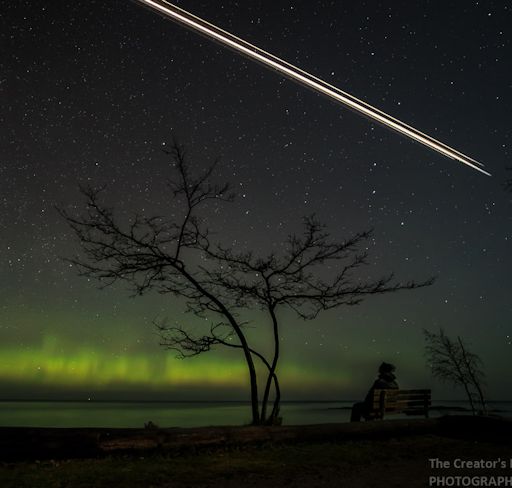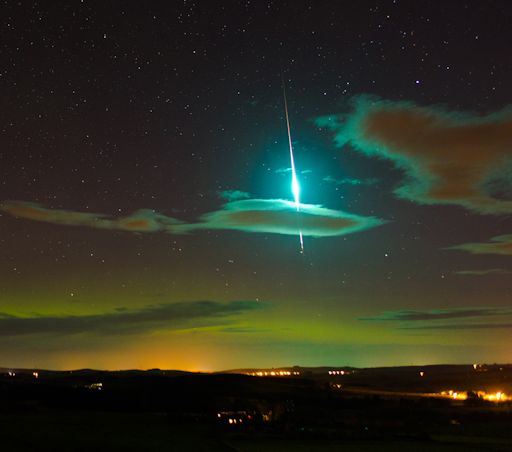On Nov. 3, 2015, the network reported 61 fireballs.
(36 sporadics, 22 Northern Taurids, 2 Orionids, 1 chi Taurid)

In this diagram of the inner solar system, all of the fireball orbits intersect at a single point--Earth. The orbits are color-coded by velocity, from slow (red) to fast (blue). [Larger image] [movies]
Bron: http://www.spaceweather.com/
http://hemel.waarnemen.com/meteoorzwermen/meteoorzwermen_2015.html#11
Naast de meteorenregens komt er ook geregeld puin van de ruimtevaartindustrie naar beneden. Dat is ook te volgen. zie onderstaande link:
http://www.satview.org/spacejunk.php
TAURID FIREBALLS:
There no longer any doubt. Earth is passing through a stream of gravelly debris from Comet Encke, source of the annual Taurid meteor shower. Meteoroids the size of pebbles, and larger, are disintegrating as they hit our planet's atmosphere at 30 km/s. To see what effect this is having on the night sky, Martin Popek of Nýdek (Czech republic) activated a low-light camera in his backyard and let it run all night long. This is what it recorded:
There were almost a dozen exploding meteors--all brighter than Venus and one as bright as a crescent Moon. "It was a very active night," says Popek.
Earth runs unto the debris zone of Comet Encke every year around this time. Usually, the encounter produces a minor meteor shower, but 2015 is different.
"This is higher than usual activity," says meteor expert Peter Brown of the University of Western Ontario. "The Canadian Meteor Orbit Radar (CMOR) is seeing stronger Taurid activity than any of the last few years. Our Southern Ontario Meteor Network cameras caught 54 Taurid fireballs from Oct 31 - Nov 4 alone, compared to 22, 18, and 32 Taurids for the entire month of November in 2014, 2013 and 2012 respectively."
These extra fireballs are coming from a "swarm" of gravelly meteoroids that weaves in and out of Comet Encke's dusty debris zone. In some years, Earth hits the swarm; in other years it misses. 2015 appears to be a hit.
"I would say with some confidence the 2015 Taurid 'swarm' is active as predicted by astronomer David Asher," adds Brown. If those predictions continue to be correct, the fireball display could carry on until Nov. 10th. The best time to look, no matter where you live, is during the hours around local midnight when the constellation Taurus is high in the sky. [meteor radar]
Bron:http://www.spaceweather.com/
MILITARY SATELLITE RE-ENTRY
The Taurid meteor shower is active, but not every fireball is a Taurid. Paul Nelson was watching the auroras over Marquette, Michigan, on Nov. 4th when he saw strange lights overhead. "There were between 10 and 20 objects of some type flying slowly across the sky from West to East and burning up upon entering the atmosphere," says Nelson. "Fortunately one of my cameras captured it."
"It was one of the strangest things I've ever witnessed," he adds.
Observers in Minnesota, Wisconsin and other parts of Michigan witnessed a similar display. Satellite expert Ted Molczan explains what they saw: "The passage of the trail through the bowl of the Big Dipper in Nelson's photo closely matches my estimate of the re-entry trajectory of NFIRE, a military satellite that decayed on Nov. 4th."
NFIRE, short for the Near-Field Infrared Experiment, was launched in 2007 aboard a Minotaur rocket from Wallops Island, Virginia. Its mission for the U.S. Missile Defense Agency was to monitor missile launches and collect data on exhaust plumes from rockets. Originally, NFIRE was supposed to carry a demonstration kill vehicle for anti-missile defense. Before launch, however, that aspect of the mission was abandoned and NFIRE went to space without a projectile experiment. NFIRE was retired in August 2015 after more than 8 years in space.
Bron: http://www.spaceweather.com/
For the second week in a row, Earth is passing through a swarm of gravelly debris from Comet Encke, source of the annual Taurid meteor shower. Over the weekend Graeme Whipps observed a pebble-sized fragment of Comet Encke disintegrating over Aberdeenshire, Scotland:

What a cracking night," says Whipps. "I don't remember seeing so many bright meteors, and the auroras weren't bad either!"
Earth runs unto the debris zone of Comet Encke every year around this time. Usually, the encounter produces a minor meteor shower, but 2015 is different. By some measures, fireball rates are 10x higher than normal. The extra fireballs are coming from a "swarm" of gravelly meteoroids that weaves in and out of Comet Encke's dusty debris zone. In most years, Earth misses the swarm. This year, however, is a hit.
The display is expected to continue until approximately Nov. 10th. The best time to look, no matter where you live, is during the hours around midnight when the constellation Taurus is high in the sky. Got clouds? Listen to Taurid radar echoes on Space Weather Radio.
Bron:http://www.spaceweather.com/

 Veel meteroren getetecteerd; Taured meteorenregen
Veel meteroren getetecteerd; Taured meteorenregen




